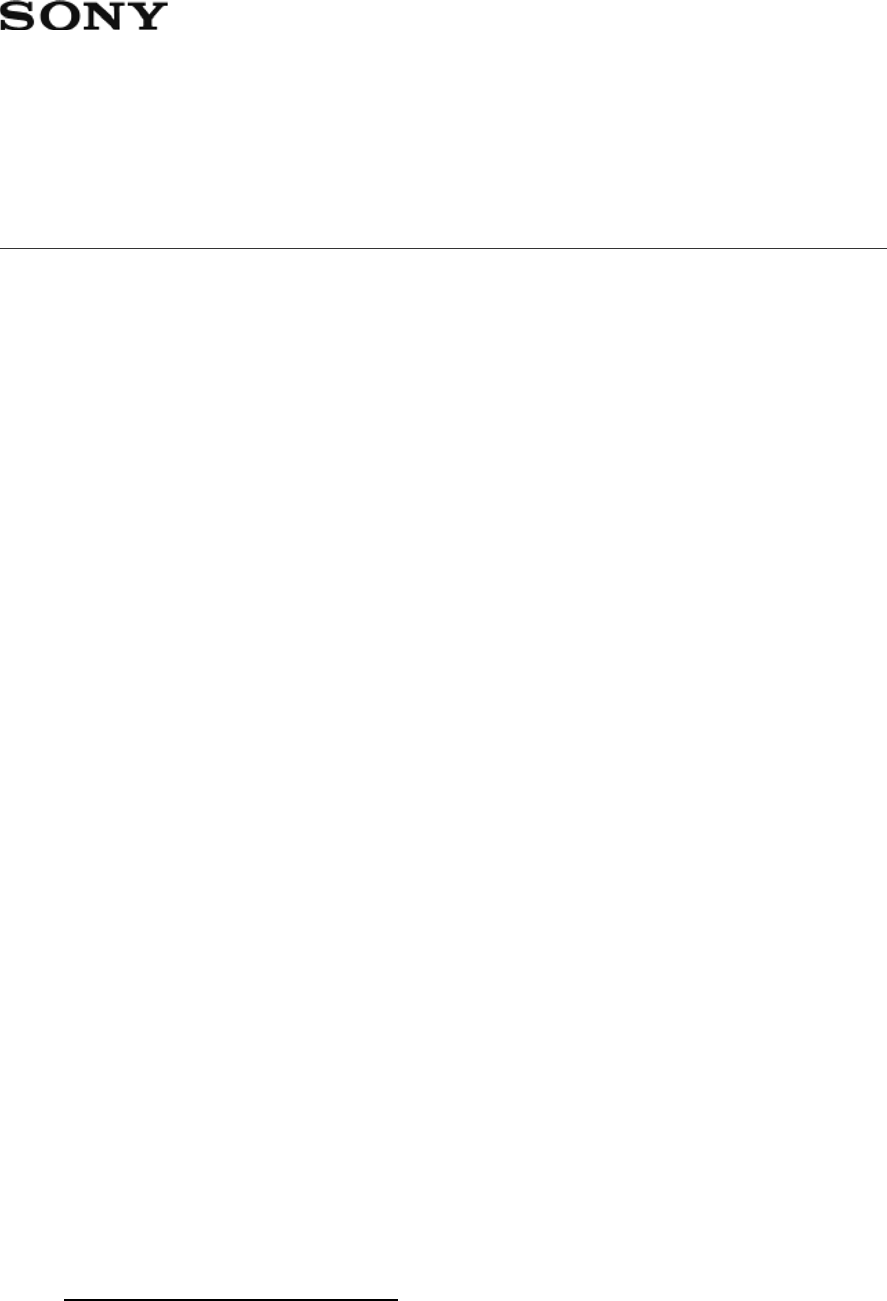Sony Group NWWM1A Digital Music Player User Manual
Sony Corporation Digital Music Player Users Manual
Contents
- 1. Users manual1
- 2. Users manual2
- 3. (Short-Term Confidential) User Manual-1
- 4. (Short-Term Confidential) User Manual-2
(Short-Term Confidential) User Manual-2

Digital Music Player NW-WM1A/WM1Z
Important product information
The following FCC statement applies only to the version of this model manufactured
for sale in the USA.
NOTE:
This equipment has been tested and found to comply with the limits for a Class B
digital device, pursuant to Part 15 of the FCC Rules. These limits are designed to
provide reasonable protection against harmful interference in a residential installation.
This equipment generates, uses and can radiate radio frequency energy and, if not
installed and used in accordance with the instructions, may cause harmful
interference to radio communications.
However, there is no guarantee that interference will not occur in a particular
installation. If this equipment does cause harmful interference to radio or television
reception, which can be determined by turning the equipment off and on, the user is
encouraged to try to correct the interference by one or more of the following
measures:
• Reorient or relocate the receiving antenna.
• Increase the separation between the equipment and receiver.
• Connect the equipment into an outlet on a circuit different from that to which the
receiver is connected.
• Consult the dealer or an experienced radio/TV technician for help.
The following FCC statement applies only to the version of this model manufactured
for sale in the USA.
You are cautioned that any changes or modifications not expressly approved in this
manual could void your authority to operate this equipment.
The following FCC statement applies only to the version of this model manufactured
for sale in the USA.
If you have any questions about this product:
Visit: www.sony.com/walkmansupport
Contact: Sony Customer Information Service Center at 1-(866)-456-7669

Write: Sony Customer Information Service Center 12451 Gateway Blvd., Fort Myers,
FL 33913
Declaration of Conformity
Trade Name:
SONY
Model No.:
NW-WM1A / NW-WM1Z
Responsible Party:
Sony Electronics Inc.
Address:
16535 Via Esprillo, San Diego, CA 92127 U.S.A
Telephone Number:
858-942-2230
This device complies with Part 15 of the FCC Rules. Operation is subject to the
following two conditions: (1) this device may not cause harmful interference, and
(2) this device must accept any interference received, including interference that
may cause undesired operation.
The following FCC statement applies only to the version of this model manufactured
for sale in the USA.
This equipment must not be co-located or operated in conjunction with any other
antenna or transmitter.
The following FCC statement applies only to the version of this model manufactured
for sale in the USA.
This equipment complies with FCC radiation exposure limits set forth for an
uncontrolled environment and meets the FCC radio frequency (RF) Exposure
Guidelines.
This equipment has very low levels of RF energy that is deemed to comply without
testing of specific absorption rate (SAR).
Notice for customers: the following information is only
applicable to equipment sold in countries applying EU directives
Manufacturer: Sony Corporation, 1-7-1 Konan Minato-ku Tokyo, 108-0075 Japan
For EU product compliance: Sony Belgium, bijkantoor van Sony Europe Limited, Da
Vincilaan 7-D1, 1935 Zaventem, Belgium

Disposal of waste batteries and electrical and electronic
equipment (applicable in the European Union and other European
countries with separate collection systems)
This symbol on the product, the battery or on the packaging indicates that the product
and the battery shall not be treated as household waste. On certain batteries this
symbol might be used in combination with a chemical symbol. The chemical symbols
for mercury (Hg) or lead (Pb) are added if the battery contains more than 0.0005%
mercury or 0.004% lead. By ensuring these products and batteries are disposed of
correctly, you will help prevent potentially negative consequences for the environment
and human health which could otherwise be caused by inappropriate waste handling.
The recycling of the materials will help to conserve natural resources.
In case of products that for safety, performance or data integrity reasons require a
permanent connection with an incorporated battery, this battery should be replaced
by qualified service staff only. To ensure that the battery and the electrical and
electronic equipment will be treated properly, hand over these products at end-of-life
to the applicable collection point for the recycling of electrical and electronic
equipment. For all other batteries, please view the section on how to remove the
battery from the product safely. Hand the battery over to the applicable collection
point for the recycling of waste batteries. For more detailed information about
recycling of this product or battery, please contact your local Civic Office, your
household waste disposal service or the shop where you purchased the product or
battery.
For users in Canada
Listening for a Lifetime
Selecting fine audio equipment such as the unit you’ve just purchased is only the start
of your musical enjoyment. Now it’s time to consider how you can maximize the fun
and excitement your equipment offers. This manufacturer, the Consumer Electronics
Association (CEA)® and the American Speech-Language-Hearing Association
(ASHA) want you to get the most out of your equipment by playing it at a safe level; a
level that lets the sound come through clearly without annoying blaring or distortion
and, most importantly, without damaging your sensitive hearing.
Sound can be deceiving. Over time your hearing “comfort level” adapts to higher
volumes of sound. So what sounds “normal” can actually be loud and harmful to your
hearing. Guard against this by setting your equipment at a safe level BEFORE your
hearing adapts.

TO ESTABLISH A SAFE LEVEL:
• Set your volume control to the lowest level where you can hear the music
comfortably and clearly. Prolonged exposure to anything over 85 decibels can
cause gradual hearing loss.
• Once you have established a sound level where you can hear the audio
comfortably, clearly and without distortion, set the dial and leave it there.
• See if your music player has a volume limiter that allows you to set a safe listening
level by establishing a maximum volume level on your player. This is a great
solution for parents to ensure their children listen at a safe level.
• Limit listening time to give your hearing “quiet breaks.”
BE SURE TO OBSERVE THE FOLLOWING GUIDELINES WHEN
WEARING YOUR HEADPHONES OR EARBUDS:
• Do not turn up the volume so high that you can’t hear sounds around you.
• Do not use headphones or earbuds while operating a motorized vehicle; it may
create a traffic hazard and is illegal in many areas.
Used wisely, your new sound equipment will provide years of fun and enjoyment.
Since hearing damage from loud noise is often undetectable until it is too late, this
manufacturer, CEA and ASHA recommend that you avoid prolonged exposure to
excessive noise. The following list of sound levels is included for your information so
that you can better protect your hearing.
DECIBEL LEVEL EXAMPLES:
30 Whisper
40 Quiet room
50 Moderate rainfall
60 Normal conversation
70 Busy traffic, vacuum cleaner
80 Alarm clock
CONSTANT EXPOSURE TO THESE NOISES CAN BE DANGEROUS:
90 Lawn mower, motorcycle
100 Chain saw
110 Rock concert
120 Jet plane takeoff
130 Jackhammer
140 Firecrackers
This information courtesy of the American Speech-Language-Hearing Association
(ASHA), the national professional, scientific and credentialing association for more
than 135,000 audiologists, speech-language pathologists, and speech, language and
hearing scientists.

For information on protection against noise-induced hearing loss, call the ASHA
Action Center (800-638-8255), Monday through Friday, 8:30 a.m. to 5 p.m. To find an
audiologist in your area, visit www.asha.org/findpro. Parents can find helpful
information about how to protect their children’s hearing and how to teach them about
safe listening at www.listentoyourbuds.org, an ASHA award-winning public education
campaign sponsored in part by CEA.
A safety tip from the Consumer Electronics Association, 1919 South Eads Street,
Arlington, VA 22202 and the American Speech-Language-Hearing Association, 2200
Research Boulevard, Rockville, MD 20850.
The following IC statement applies only to the version of this model manufactured for
sale in Canada.
The available scientific evidence does not show that any health problems are
associated with using low power wireless devices. There is no proof, however, that
these low power wireless devices are absolutely safe. Low power Wireless devices
emit low levels of radio frequency energy (RF) in the microwave range while being
used. Whereas high levels of RF can produce health effects (by heating tissue),
exposure of low-level RF that does not produce heating effects causes no known
adverse health effects. Many studies of low-level RF exposures have not found any
biological effects. Some studies have suggested that some biological effects might
occur, but such findings have not been confirmed by additional research. These
models have been tested and found to comply with IC radiation exposure limits set
forth for an uncontrolled environment and meets RSS-102 of the IC radio frequency
(RF) Exposure rules.
The following IC statement applies only to the version of this model manufactured for
sale in Canada.
This device complies with Industry Canada's licence-exempt RSSs. Operation is
subject to the following two conditions:
(1) This device may not cause interference; and
(2) This device must accept any interference, including interference that may cause
undesired operation of the device.
Refer to the information in the other supplied manuals such as the printed manuals
and the “Help Guide.”